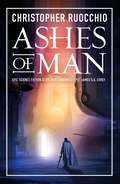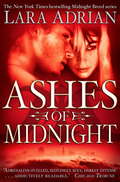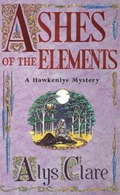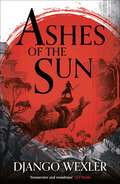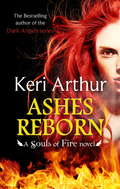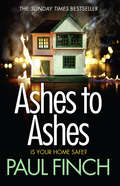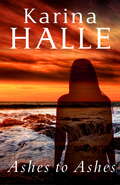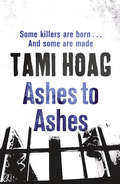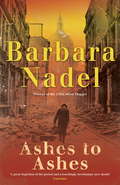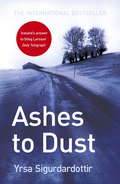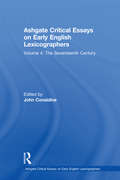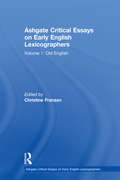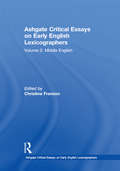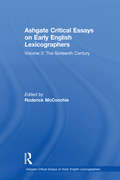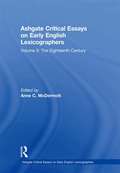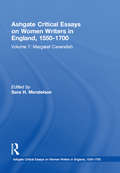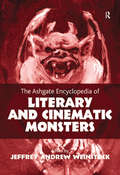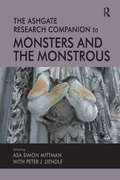- Table View
- List View
Ashes of Man (Sun Eater)
by Christopher RuocchioThe galaxy is burning.With the Cielcin united under one banner, the Sollan Empire stands alone after the betrayal of the Commonwealth. The Prophet-King of the Cielcin has sent its armies to burn the worlds of men, and worse, there are rumours... whispers that Hadrian Marlowe is dead, killed in the fighting.But it is not so. Hadrian survived with the help of the witch, Valka, and together they escaped the net of the enemy having learned a terrible truth: the gods that the Cielcin worship are real and will not rest until the universe is dark and cold.What is more, the Emperor himself is in danger. The Prophet-King has learned to track his movements as he travels along the borders of Imperial space. Now the Cielcin legions are closing in, their swords poised to strike off the head of all mankind.
Ashes of Midnight (Midnight Breed #6)
by Lara AdrianA woman driven by blood. A man thirsting for vengeance...As night falls, Claire Roth flees, driven from her home by a fiery threat that seems to come from hell itself. Then, from out the flames and ash, a vampire warrior emerges. He is Andreas Reichen, her one-time lover but now a stranger consumed by vengeance. Caught in the crossfire, Claire cannot escape his savage fury - or the hunger that plunges her into his world of eternal darkness and unending pleasure.Nothing will stop Andreas from destroying the vampire responsible for slaughtering his Breed brethren... even if he must use his former lover as a pawn in his deadly mission. Claire can lead Andreas to the enemy he seeks but it is a journey fraught with danger - and deep desire. For Claire is the one woman Andreas should not crave, and the only one he's ever loved. So a dangerous seduction begins - one which blurs the line between predator and prey, love and hate...
Ashes of the Elements (Hawkenlye Ser. #Bk. 2)
by Alys ClareA grove of huge oak trees in the Wealden forest is felled. And, as if some ancient curse is being brought alive, the man who wielded the axes meets with a violent end.The Sheriff claims the Forest People did it, but Abbess Helewise believes a supernatural solution is too easy an answer. She consults Josse d'Acquin, whose manor house in the Weald is now being renovated, and he, concerned about the safety of two girls from the abbey, enters the forest himself - to find something in this ancient part of Britain that terrifies even him.
Ashes of the Sun (Burningblade and Silvereye #1)
by Django Wexler'Ashes of the Sun is fantasy at its finest' Nicholas Eames, author of Kings of the WyldFour hundred years ago, a cataclysmic war cracked the world open. Amid the ashes, the Dawn Republic now stands guard over lands littered with eldritch relics and cursed by plaguespawn outbreaks. But a new conflict is looming and brother and sister Gyre and Maya have found themselves on opposite sides of it.At the age of five, Maya was taken by the Twilight Order and trained to be a centarch, wielding forbidden arcana to enforce the Dawn Republic's rule. On that day, her brother, Gyre, swore to destroy the Order that stole his sister... whatever the cost.Twelve years later, brother and sister are two very different people: she is the Twilight Order's brightest prodigy; he is a thief, bandit and revolutionary. Together, the siblings will discover that not even ties of blood will keep them from splitting the world in two. Praise for Ashes of the Sun:'Wexler's best work yet... Ashes of the Sun has scale and pace, and tension and batshit cool scenery, and I enjoyed it a hell of a lot' Tor.com'A fast-paced and highly entertaining ride through a compelling and original world' Anthony Ryan'Wexler is a master of high fantasy' S.M. Stirling'A perfect page turner and a phenomenal start to a new series' Peter Clines
Ashes Reborn (Souls of Fire #4)
by Keri ArthurThe clock is ticking as Emberly - a phoenix capable of taking human form - races to take revenge against the sadistic and mysterious Rinaldo. The elusive rebel leader threatens to keep killing until he is given all of the research about a plaguelike virus derived from vampire blood.Forced to reach out to the Paranormal Investigations Team for help, Emberly and her partner, Jackson, must decide who to trust as they follow the trail of dead bodies. When classified information is leaked and their safe house is ambushed, Emberly's suspicions are confirmed - someone at PIT has betrayed them. A final battle looms and Emberly will need to command all her powers - or watch the world turn to ash...
Ashes to Ashes: Is Your Home Safe? (Detective Mark Heckenburg #6)
by Paul FinchThe Sunday Times bestseller returns with his next unforgettable crime thriller. Fans of MJ Arlidge and Stuart MacBride won’t be able to put this down.
Ashes to Ashes (Experiment in Terror #Bk. 8)
by Karina HalleThey are each other's anchors . . . and the storm is far from over. It's been two months since Perry Palomino and Dex Foray's relationship reached a new turning point, two months since Perry started a new life in Seattle, and two months since their Experiment in Terror show took on a new partner, ex-Wine Babe Rebecca Sims, and a newfound level of success. But whenever there is light in their lives, the madness still has a way of coming back in.When the team is sent back to the stormy Oregon coast to investigate a haunted school, Perry wants to use the opportunity to reconnect with her family and reintroduce Dex into their lives. Only Perry's not the only one who's reaching out - her grandmother Pippa has started appearing to her with disturbing warnings and Perry's presence at the school has ignited a chilling new wave of supernatural phenomenon. Once used a century ago as a sanatorium to house children dying of tuberculosis, the school's past residents are slowly coming back to life and with one thing on their mind: They want someone to play with, someone to join them. Forever.Even when dead, some children get whatever they want.And they want Perry.
Ashes To Ashes: Ashes To Ashes; Dust To Dust; Dark Horse (Kovac & Liska #1)
by Tami HoagThe first book in the Kovac and Liska series, one of the most engaging detective duos in crime thrillers. In ASHES TO ASHES they join FBI agent Kate Conlan as she tracks a serial killer known as The Cremator. A killer performs a bizarre ceremony in a wooded Minneapolis park, setting the bodies ablaze. He has already claimed three lives, and he won't stop there. Only this time there is a witness. But she isn't talking.Kate Conlan - former FBI agent - is assigned to the case. Her superiors are on the case as the latest victim may be the daughter of Peter Bondurant, an enigmatic billionaire. When Peter pulls strings, Special Agent John Quinn gets assigned to the case. But the FBI's ace profiler of serial killers is the last person Kate wants to work with, not with their troubled history. Now she faces the most difficult role of her career-and her life. For she's the only woman who has what it takes to stop the killer . . . and the one woman he wants next.Watch out for the next title in the Kovac and Liska crime thriller seriesThe death of internal affairs investigator Andy Paxton is a potential political bomb for the Minneapolis Police Department. Paxton was investigating a possible cop connection in the brutal murder of another officer. The pressure is on from the top brass to close the case as soon as possible but Sam Kovac is not convinced the case is as straightforward as it appears. As he digs deeper, it is looking very much like Paxton discovered something that got him killed. DUST TO DUST is the next gripping thriller in the series.
Ashes to Ashes: A page-turning World War Two crime thriller (Hancock Ser. #6)
by Barbara NadelAs London burns, an unlikely hero unearths a series of brutal murders...Ashes to Ashes is the third novel in the acclaimed Francis Hancock World War Two crime series by Barbara Nadel. Perfect for fans of Martin Walker and Maureen Jennings. 'A great depiction of the period and a touchingly involuntary new sleuth' - Guardian As the German Luftwaffe bomb the capital, undertaker Francis Hancock suddenly finds himself caught up in the middle of a terrifying abduction plot.It's 29 December, 1940, the night that Hitler has chosen to destroy London under a barrage of flaming incendiary bombs. Their main target - St Paul's cathedral - is where Hancock is sheltering from the onslaught. But the First World War veteran doesn't just have bombs to contend with; a young girl, who was also sheltering in the cathedral, has vanished. Then some of those charged with protecting the building are brutally murdered. Hancock must face his own demons and fears in his struggle to catch those responsible and bring them to justice...What readers are saying about Ashes to Ashes:'The details of people's ordinary lives adds so much depth to the story''The tale covers madness, loyalty, patriotism, priorities, faith - all the deep stuff Barbara Nadel tackles so well''Barbara Nadel is a seriously perceptive, interesting writer'
Ashes to Dust: Thora Gudmundsdottir Book 3 (Thora Gudmundsdottir)
by Yrsa SigurdardottirThe third crime novel from international bestseller Yrsa Sigurdardottir, ASHES TO DUST is tense, taut and terrifying - not to be missed for fans of Nordic Noir. Thora peered at the floor, but couldn't see anything that could have frightened Markus that much, only three mounds of dust. She moved the light of her torch over them. It took her some time to realize what she was seeing-- and then it was all she could do not to let the torch slip from her hand. 'Good God,' she said. She ran the light over the three faces, one after another. Sunken cheeks, empty eye-sockets, gaping mouths; they reminded her of photographs of mummies she'd once seen in National Geographic. 'Who are these people?''I don't know,' said Markus...Bodies are discovered in one of the excavated houses at a volcanic tourist attraction dubbed 'The Pompeii of the North'.Markus Magnusson, who was only a teenager when the volcano erupted, falls under suspicion and hires attorney Thora Gudmundsdottir to defend him - but when his childhood sweetheart is murdered his case starts to look more difficult, and the locals seem oddly reluctant to back him up . . .
Ashgate Critical Essays on Early English Lexicographers: Volume 4: The Seventeenth Century (Ashgate Critical Essays on Early English Lexicographers)
by John ConsidineThree major developments in English lexicography took place during the seventeenth century: the emergence of the first free standing monolingual English dictionaries; the making of new kinds of English lexicons that investigated dialect or etymology or that keyed English to invented 'philosophical' languages; and the massive expansion of bilingual lexicography, which not only placed English alongside the European vernaculars but also handled the languages of the new world. The essays in this volume discuss not only the internal history of lexicography but also its wider relationships with culture and society.
Ashgate Critical Essays on Early English Lexicographers: Volume 4: The Seventeenth Century (Ashgate Critical Essays on Early English Lexicographers)
by John ConsidineThree major developments in English lexicography took place during the seventeenth century: the emergence of the first free standing monolingual English dictionaries; the making of new kinds of English lexicons that investigated dialect or etymology or that keyed English to invented 'philosophical' languages; and the massive expansion of bilingual lexicography, which not only placed English alongside the European vernaculars but also handled the languages of the new world. The essays in this volume discuss not only the internal history of lexicography but also its wider relationships with culture and society.
Ashgate Critical Essays on Early English Lexicographers: Volume 1: Old English (Ashgate Critical Essays on Early English Lexicographers)
by Christine FranzenAnglo-Saxon lexicography studies Latin texts and words. The earliest English lexicographers are largely unidentifiable students, teachers, scholars and missionaries. Materials brought from abroad by early teachers were augmented by their teachings and passed on by their students. Lexicographical material deriving from the early Canterbury school remains traceable in glossaries throughout this period, but new material was constantly added. Aldhelm and Ælfric Bata, among others, wrote popular, much studied hermeneutic texts using rare, exotic words, often derived from glossaries, which then contributed to other glossaries. Ælfric of Eynsham is a rare identifiable early English lexicographer, unusual in his lack of interest in hermeneutic vocabulary. The focus is largely on context and the process of creation and intended use of glosses and glossaries. Several articles examine intellectual centres where scholars and texts came together, for example, Theodore and Hadrian in Canterbury; Aldhelm in Malmesbury; Dunstan at Christ Church, Canterbury; Æthelwold in Winchester; King Æthelstan's court; Abingdon; Glastonbury; and Worcester.
Ashgate Critical Essays on Early English Lexicographers: Volume 1: Old English (Ashgate Critical Essays on Early English Lexicographers)
by Christine FranzenAnglo-Saxon lexicography studies Latin texts and words. The earliest English lexicographers are largely unidentifiable students, teachers, scholars and missionaries. Materials brought from abroad by early teachers were augmented by their teachings and passed on by their students. Lexicographical material deriving from the early Canterbury school remains traceable in glossaries throughout this period, but new material was constantly added. Aldhelm and Ælfric Bata, among others, wrote popular, much studied hermeneutic texts using rare, exotic words, often derived from glossaries, which then contributed to other glossaries. Ælfric of Eynsham is a rare identifiable early English lexicographer, unusual in his lack of interest in hermeneutic vocabulary. The focus is largely on context and the process of creation and intended use of glosses and glossaries. Several articles examine intellectual centres where scholars and texts came together, for example, Theodore and Hadrian in Canterbury; Aldhelm in Malmesbury; Dunstan at Christ Church, Canterbury; Æthelwold in Winchester; King Æthelstan's court; Abingdon; Glastonbury; and Worcester.
Ashgate Critical Essays on Early English Lexicographers: Volume 2: Middle English (Ashgate Critical Essays on Early English Lexicographers)
by Christine FranzenThe teaching of Latin remained important after the Conquest but Anglo-Norman now became a language of instruction and, from the thirteenth century onwards, a language to be learned. During this period English lexicographers were more numerous, more identifiable and their works more varied, for example: the tremulous hand of Worcester created an Old English-Latin glossary, and Walter de Bibbesworth wrote a popular contextualized verse vocabulary of Anglo-Norman country life and activities. The works and techniques of Latin scholars such as Adam of Petit Point, Alexander Nequam, and John of Garland were influential throughout the period. In addition, grammarians' and schoolmasters' books preserve material which in some cases seems to have been written by them. The material discussed ranges from a twelfth-century glossary written at a minor monastic house to four large alphabetical fifteenth-century dictionaries, some of which were widely available. Some material seems to connect with the much earlier Old English glossaries in ways not yet fully understood.
Ashgate Critical Essays on Early English Lexicographers: Volume 2: Middle English (Ashgate Critical Essays on Early English Lexicographers)
by Christine FranzenThe teaching of Latin remained important after the Conquest but Anglo-Norman now became a language of instruction and, from the thirteenth century onwards, a language to be learned. During this period English lexicographers were more numerous, more identifiable and their works more varied, for example: the tremulous hand of Worcester created an Old English-Latin glossary, and Walter de Bibbesworth wrote a popular contextualized verse vocabulary of Anglo-Norman country life and activities. The works and techniques of Latin scholars such as Adam of Petit Point, Alexander Nequam, and John of Garland were influential throughout the period. In addition, grammarians' and schoolmasters' books preserve material which in some cases seems to have been written by them. The material discussed ranges from a twelfth-century glossary written at a minor monastic house to four large alphabetical fifteenth-century dictionaries, some of which were widely available. Some material seems to connect with the much earlier Old English glossaries in ways not yet fully understood.
Ashgate Critical Essays on Early English Lexicographers: Volume 3: The Sixteenth Century (Ashgate Critical Essays on Early English Lexicographers)
by Roderick McConchieLaying the foundations for the first monolingual dictionaries of English, the sixteenth century in English lexicography is here shown to form a bridge between the glossarial compilations which had slowly evolved during the Middle Ages, and the more recognisably modern dictionary incorporating synonymy, illustrative citations and other standard features. The articles collected here treat general lexicography and dictionaries in this period, their uses, and the state of research in this field. The volume also covers a fascinating and diverse collection of lexicographers, from the well known - John Palsgrave, Thomas Cooper, Thomas Elyot and John Florio - to those about whom next to nothing is known - Richard Howlet, John Baret and Peter Levens.
Ashgate Critical Essays on Early English Lexicographers: Volume 3: The Sixteenth Century (Ashgate Critical Essays on Early English Lexicographers)
by Roderick McConchieLaying the foundations for the first monolingual dictionaries of English, the sixteenth century in English lexicography is here shown to form a bridge between the glossarial compilations which had slowly evolved during the Middle Ages, and the more recognisably modern dictionary incorporating synonymy, illustrative citations and other standard features. The articles collected here treat general lexicography and dictionaries in this period, their uses, and the state of research in this field. The volume also covers a fascinating and diverse collection of lexicographers, from the well known - John Palsgrave, Thomas Cooper, Thomas Elyot and John Florio - to those about whom next to nothing is known - Richard Howlet, John Baret and Peter Levens.
Ashgate Critical Essays on Early English Lexicographers: Volume 5: The Eighteenth Century (Ashgate Critical Essays on Early English Lexicographers)
by Anne C. McDermottThe eighteenth century is renowned for the publication of Samuel Johnson's A Dictionary of the English Language, which reference sources still call the first English dictionary. This collection demonstrates the inaccuracy of that claim, but its tenacity in the public mind testifies to how decisively Johnson formed our sense of what a dictionary is. The essays and articles in this volume examine the already flourishing tradition of English lexicography from which Johnson drew, as represented by Kersey, Bailey, and Martin, as well as the flourishing contemporary trade in encyclopedic, technical, pronunciation, and bilingual lexicons.
Ashgate Critical Essays on Early English Lexicographers: Volume 5: The Eighteenth Century (Ashgate Critical Essays on Early English Lexicographers)
by Anne C. McDermottThe eighteenth century is renowned for the publication of Samuel Johnson's A Dictionary of the English Language, which reference sources still call the first English dictionary. This collection demonstrates the inaccuracy of that claim, but its tenacity in the public mind testifies to how decisively Johnson formed our sense of what a dictionary is. The essays and articles in this volume examine the already flourishing tradition of English lexicography from which Johnson drew, as represented by Kersey, Bailey, and Martin, as well as the flourishing contemporary trade in encyclopedic, technical, pronunciation, and bilingual lexicons.
Ashgate Critical Essays on Women Writers in England, 1550-1700: Volume 7: Margaret Cavendish (Ashgate Critical Essays on Women Writers in England, 1550-1700)
by Sara H. MendelsonA maverick in her own time, Margaret Cavendish, Duchess of Newcastle (1623-1673) was dismissed for three centuries as an eccentric crank. Yet the past few decades have witnessed a true renaissance in Cavendish studies, as scholars from diverse academic disciplines produce books, articles and theses on every aspect of her oeuvre. Cavendish's literary creations hold a wide appeal for modern readers because of her talent for thinking outside the rigid box that delimited the hierarchies of class, race and gender in seventeenth-century Europe. In so doing, she challenged the ultimate building blocks of early modern society, whether the tenets of Christianity, the social and political imperatives of patriarchy, or the arrogant claims of the new Baconian science. At the same time, Cavendish offers keen insights into current social issues. Her works have become a springboard for critical discourse on such topics as the nature of gender difference and the role of science in human life. Sara Mendelson's aim in compiling this volume is to convey to readers some idea of the scope and variety of scholarship on Cavendish, not only in terms of dominant themes, but of critical controversies and intriguing new pathways for investigation.
Ashgate Critical Essays on Women Writers in England, 1550-1700: Volume 7: Margaret Cavendish (Ashgate Critical Essays on Women Writers in England, 1550-1700)
by Sara H. MendelsonA maverick in her own time, Margaret Cavendish, Duchess of Newcastle (1623-1673) was dismissed for three centuries as an eccentric crank. Yet the past few decades have witnessed a true renaissance in Cavendish studies, as scholars from diverse academic disciplines produce books, articles and theses on every aspect of her oeuvre. Cavendish's literary creations hold a wide appeal for modern readers because of her talent for thinking outside the rigid box that delimited the hierarchies of class, race and gender in seventeenth-century Europe. In so doing, she challenged the ultimate building blocks of early modern society, whether the tenets of Christianity, the social and political imperatives of patriarchy, or the arrogant claims of the new Baconian science. At the same time, Cavendish offers keen insights into current social issues. Her works have become a springboard for critical discourse on such topics as the nature of gender difference and the role of science in human life. Sara Mendelson's aim in compiling this volume is to convey to readers some idea of the scope and variety of scholarship on Cavendish, not only in terms of dominant themes, but of critical controversies and intriguing new pathways for investigation.
The Ashgate Encyclopedia of Literary and Cinematic Monsters
by Jeffrey Andrew WeinstockFrom vampires and demons to ghosts and zombies, interest in monsters in literature, film, and popular culture has never been stronger. This concise Encyclopedia provides scholars and students with a comprehensive and authoritative A-Z of monsters throughout the ages. It is the first major reference book on monsters for the scholarly market. Over 200 entries written by experts in the field are accompanied by an overview introduction by the editor. Generic entries such as 'ghost' and 'vampire' are cross-listed with important specific manifestations of that monster. In addition to monsters appearing in English-language literature and film, the Encyclopedia also includes significant monsters in Spanish, French, Italian, German, Russian, Indian, Chinese, Japanese, African and Middle Eastern traditions. Alphabetically organized, the entries each feature suggestions for further reading. The Ashgate Encyclopedia of Literary and Cinematic Monsters is an invaluable resource for all students and scholars and an essential addition to library reference shelves.
The Ashgate Encyclopedia of Literary and Cinematic Monsters
by Jeffrey Andrew WeinstockFrom vampires and demons to ghosts and zombies, interest in monsters in literature, film, and popular culture has never been stronger. This concise Encyclopedia provides scholars and students with a comprehensive and authoritative A-Z of monsters throughout the ages. It is the first major reference book on monsters for the scholarly market. Over 200 entries written by experts in the field are accompanied by an overview introduction by the editor. Generic entries such as 'ghost' and 'vampire' are cross-listed with important specific manifestations of that monster. In addition to monsters appearing in English-language literature and film, the Encyclopedia also includes significant monsters in Spanish, French, Italian, German, Russian, Indian, Chinese, Japanese, African and Middle Eastern traditions. Alphabetically organized, the entries each feature suggestions for further reading. The Ashgate Encyclopedia of Literary and Cinematic Monsters is an invaluable resource for all students and scholars and an essential addition to library reference shelves.
The Ashgate Research Companion to Monsters and the Monstrous
by Asa Simon Mittman and Peter J. DendleThe field of monster studies has grown significantly over the past few years and this companion provides a comprehensive guide to the study of monsters and the monstrous from historical, regional and thematic perspectives. The collection reflects the truly multi-disciplinary nature of monster studies, bringing in scholars from literature, art history, religious studies, history, classics, and cultural and media studies. The companion will offer scholars and graduate students the first comprehensive and authoritative review of this emergent field.
